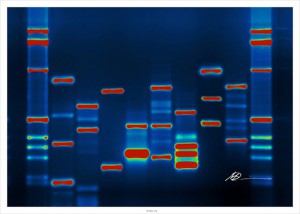
There are no best practices for turning patient's genome sequence into information that a doctor can easily understand…and act on. Children's Hospital Boston's CLARITY Challenge calls on the genomics community to come up with those practices, and possibly help three families in the process. (michab37/Flickr)
Personalized medicine, harnessing genomics to improve patient care, is a great idea on paper. But investigators have long struggled to find a smooth route from the bench – where patients’ DNA samples are sequenced – to the bedside, where a doctor can use a genomics report to diagnose illness, prescribe treatments and offer means of prevention.
Looking for innovations, Children’s Hospital Boston decided to use the incentive of competition, launching a contest called the CLARITY Challenge. The winner will be the company or group that can best translate the science of genomics into tools and methods that integrate into and inform everyday care.
Here’s how it will work. The Manton Center for Orphan Disease Research at Children’s will provide raw DNA sequence data – generated by contest sponsors Life Technologies Corporation and Complete Genomics – and clinical summaries from three children and their families. Each child has a disease with an as-yet unknown genetic basis. Teams of contestants must figure out how to get from DNA sequence to root cause and, finally, to a report that a physician can easily use to guide recommendations about care.
In this contest, we all win
Using a contest to drive innovation isn’t new. The poster child is the Ansari X PRIZE, a competition that spurred the development of commercial space flight. Within genomics, there’s the Archon Genomics X prize, a $10 million award for the first team to successfully sequence 100 human genomes in 10 days. There are also the Ion Torrent prizes, $1 million apiece, for any research team that boosts the speed, quantity and accuracy of Ion Torrent’s Personal Genome Machine.
But CLARITY (which stands for Children’s Leadership Award for the Reliable Interpretation and appropriate Transmission of Your genomic information) is different. It does not focus on laboratory elegance or speed of sequencing. Neither does it reward gene sleuthing for the mutations underlying a patient’s or family’s disease, as is now in vogue, according to the journal Nature.
Instead, CLARITY reaches for…well…clarity: Can genomic information be conveyed in a report that a doctor can read and interpret in a way that tangibly helps the patient?
Other genomics efforts, some very well bankrolled, have tried and failed to do this. And so the question arises as to why Children’s researchers, offering a modest reward of $25,000, would have the audacity to think they could do better.
The answer is prestige. Prizes draw attention to a cause someone considers worthy of discovery. Contests create a community, which anyone who is anyone wants to join. And scientific competitions can draw out innovation from the most unexpected places.
“If researchers are out in Bulgaria or Kansas, they might not be able to compete with the big boys,” says Children’s bioinformatics guru Isaac Kohane, who is leading the Challenge with partners David Margulies, director of The Gene Partnership (a Children’s initiative that will eventually deploy the innovations that come out of the contest locally at the hospital and, in time, on a global scale); and Alan Beggs, director of the Manton Center. “Here we are giving everyone a level playing field, saying ‘go for it, innovate, compete.’ ”
Calling all genomicists
Creating the prize was a community effort. Kohane approached Margulies and colleagues and hosted a conference in 2010 aimed at addressing the challenges of providing consistent and clinically useful information to physicians and their patients based on large-scale genome sequencing. The Clinical Bioinformatics Summit at Harvard Medical School was covered in Bio IT World and attended by 110 handpicked stakeholders (from basic researchers to biotech executives to clinical laboratory directors). Among the conference’s outcomes was recognition of the need for clear standards of clinical utility and open comparisons of evolving techniques, methods, findings, and interpretations for a particular specimen – the seeds of the CLARITY Challenge.
Will you take the Challenge?
Registration opens today at http://www.childrenshospital.org/CLARITY and closes on March 1. Twenty teams will be selected to participate; those teams will be announced and the sequences released to them in April. A panel of judges will evaluate the contestants’ entries on their technical approach, the accuracy of the findings and the readability of the report.
The winner will be announced in October.
“We have catalyzed the more advanced thinking about what it would really take to get this genomic medicine to become real,” Kohane says. “I expect that we will be surprised and gratified by how well teams will do.”







